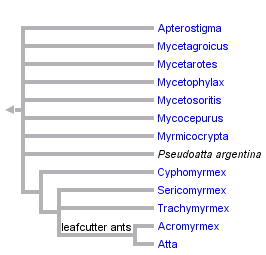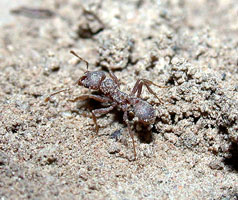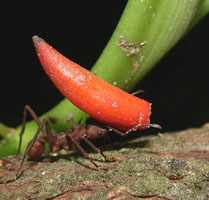Attini
Fungus-growing ants



This tree diagram shows the relationships between several groups of organisms.
The root of the current tree connects the organisms featured in this tree to their containing group and the rest of the Tree of Life. The basal branching point in the tree represents the ancestor of the other groups in the tree. This ancestor diversified over time into several descendent subgroups, which are represented as internal nodes and terminal taxa to the right.

You can click on the root to travel down the Tree of Life all the way to the root of all Life, and you can click on the names of descendent subgroups to travel up the Tree of Life all the way to individual species.
For more information on ToL tree formatting, please see Interpreting the Tree or Classification. To learn more about phylogenetic trees, please visit our Phylogenetic Biology pages.
close boxCharacteristics
The Attini share the following synapomorphy with the Blepharidattini (Bolton 2003):- Anterior clypeal margin with a broad anteclypeal apron or flange that fits tightly over basal margins of mandibles at an angle to outline of clypeus; anteclypeal apron of a different sculpture/texture from median portion of clypeus
- Median clypeal seta arises from below level of other setae
- Frontal lobes broad, with strongly convex outer margins that are constricted or pinched-in posteriorly
- Larvae with leg vestiges represented by open integumental slits, with short and narrow labrum, and fleshy, subconical, nearly straight mandibles
- Cultivate fungi (yeast or mycelium)
References
Baroni Urbani, C. 1980. First description of fossil gardening ants (Amber Collection Stuttgart and Natural History Museum Basel, Hymenoptera: Formicidae. 1: Attini). Stuttgarter Beitraege zur Naturkunde Serie B (Geologie und Palaeontologie) No. 54: 1-13.
Bolton, B. 1994. Identification Guide to the Ant Genera of the World. Cambridge, MA: Harvard University Press.
Bolton, B. 1995. A New General Catalogue of the Ants of the World. Cambridge, MA: Harvard University Press.
Bolton, B. 2003. Synopsis and Classification of Formicidae. 370 pp. Memoirs of the American Entomological Institute, Vol. 71. Gainesville, FL.
Brandão, C. R. F. and A. J. Mayhé-Nunes. 2001. A new fungus-growing ant genus, Mycetagroicus gen. n., with the description of three new species and comments on the monophyly of the Attini. Sociobiology 38: 639-665.
Chapela, I. H., S. A. Rehner, T. R. Schultz, and U. G. Mueller. 1994. Evolutionary history of the symbiosis between fungus-growing ants and their fungi. Science 266 (5191): 1691-1694.
Currie, C. R., B. Wong, A. E. Stuart, T. R. Schultz, S. A. Rehner, U. G. Mueller, G. H. Sung, J. W. Spatafora, and N. A. Straus. 2003. Ancient tripartite coevolution in the attine ant-microbe symbiosis. Science 299 (5605): 386-388.
Hölldobler, B. and E. O. Wilson. 1990. The Ants. Cambridge, MA: Harvard University Press.
Lattke, J. E. 1999. A new species of fungus-growing ant and its implications for attine phylogeny. Systematic Entomology 24: 1-6.
Mueller, U. G., T. R. Schultz, C. R. Currie, R. M. Adams, and D. Malloch. 2001. The origin of the attine ant-fungus mutualism. Quarterly Review of Biology 76(2): 169-197.
Schultz, T. R. and R. Meier. 1995. A phylogenetic analysis of the fungus-growing ants based on morphological characters of the larvae. Systematic Entomology 20: 337-370.
Villesen, P., T. Murakami, T. R. Schultz, J. J. Boomsma. 2002. Identifying the transition between single and multiple mating of queens in fungus-growing ants. Proceedings of the Royal Society, Biological Sciences Series B 269 (1500): 1541-1548.
Wetterer, J. K., T. R. Schultz, and R. Meier. 1998. Phylogeny of fungus-growing ants (Tribe Attini) based on mtDNA sequence and morphology. Molecular Phylogenetics and Evolution 9(1): 42-47.
Wheeler, G. C. & Wheeler, J. 1976. Ant larvae: review and synthesis. Memoirs of the Entomological Society of Washington 74: 1-108.
Title Illustrations

| Scientific Name | Mycetophylax emeryi |
|---|---|
| Location | Paraguay |
| Sex | Female |
| Life Cycle Stage | Worker |
| Copyright |
© 2003 Alex Wild

|
| Scientific Name | Atta cephalotes |
|---|---|
| Location | Ecuador |
| Comments | The smaller, minima worker riding on the leaf fragment protects the lower ant from attacks by phorid fly parasitoids. |
| Sex | Female |
| Life Cycle Stage | Workers |
| Copyright |
© 2003 Alex Wild

|
| Scientific Name | Acromyrmex octospinosus |
|---|---|
| Location | Guatemala |
| Comments | One of two genera of leafcutter ants |
| Sex | Female |
| Life Cycle Stage | Worker |
| Copyright |
© 2003 Alex Wild

|
About This Page
Page copyright © 2004
 Page: Tree of Life
Attini. Fungus-growing ants.
The TEXT of this page is licensed under the
Creative Commons Attribution-NonCommercial License - Version 3.0. Note that images and other media
featured on this page are each governed by their own license, and they may or may not be available
for reuse. Click on an image or a media link to access the media data window, which provides the
relevant licensing information. For the general terms and conditions of ToL material reuse and
redistribution, please see the Tree of Life Copyright
Policies.
Page: Tree of Life
Attini. Fungus-growing ants.
The TEXT of this page is licensed under the
Creative Commons Attribution-NonCommercial License - Version 3.0. Note that images and other media
featured on this page are each governed by their own license, and they may or may not be available
for reuse. Click on an image or a media link to access the media data window, which provides the
relevant licensing information. For the general terms and conditions of ToL material reuse and
redistribution, please see the Tree of Life Copyright
Policies.
- First online 22 March 2004
Citing this page:
Tree of Life Web Project. 2004. Attini. Fungus-growing ants. Version 22 March 2004 (temporary). http://tolweb.org/Attini/22435/2004.03.22 in The Tree of Life Web Project, http://tolweb.org/











 Go to quick links
Go to quick search
Go to navigation for this section of the ToL site
Go to detailed links for the ToL site
Go to quick links
Go to quick search
Go to navigation for this section of the ToL site
Go to detailed links for the ToL site